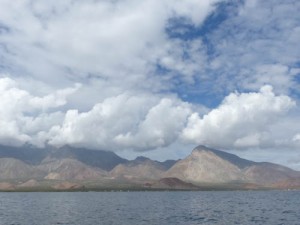 On Sept. 7, we left our rustic confines of Puerto Santo Tomas and made the all-day trek to Bahia de Los Angeles on the Sea of Cortez. It was a long haul – about 8 hours – but we made good time despite the many diversions, potty breaks, washouts, potholes, big rigs and roaming livestock that marked our journey down the main (and only) state highway 1.
On Sept. 7, we left our rustic confines of Puerto Santo Tomas and made the all-day trek to Bahia de Los Angeles on the Sea of Cortez. It was a long haul – about 8 hours – but we made good time despite the many diversions, potty breaks, washouts, potholes, big rigs and roaming livestock that marked our journey down the main (and only) state highway 1.
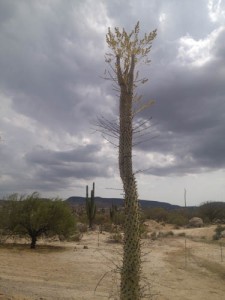
The drive was both beautiful and nerve wracking. The two-lane highway has no shoulders and winds around mountainsides with steep drop offs and sharp curves. When you see road signs telling you to slow down or that a dangerous curve is ahead, you’d better obey them (in fact, there are road signs that say, “obey the signs”). The warnings don’t exaggerate. There is no wiggle room for oversteering, and you never know when a giant vehicle will come barreling down the highway toward you, over the center line. I now understand why everyone advises never to drive in Baja at night. It would be a death sentence. Furthermore, if you drove at night you’d miss all the amazing scenery: cardon cactus, Boojum (cirios) trees and cholla as far as the eye can see, towering mountains, giant piles of car-sized boulders, and wide arroyos lined with palm trees.

The weather in Valle de Guadalupe and Puerto Santo Tomas was perfect – in the 80s during the day, and cooling down to the high 60s at night. The closer we got to Bahia de los Angeles, the hotter it got. I kept my eye on the temperature gauge on the car – 80…85…95…it reached a high point of 99 around Catavina smack in the middle of the desert between the Pacific Ocean and Sea of Cortez. I kept hoping that the temperature would cool off the closer we got to the Sea of Cortez, but it stayed in the high 90s (and humid) all the way to the coast. Getting out of our air-conditioned car was like walking into a steam room.
Upon arriving in Bahia, we spent an hour driving around looking for affordable, air conditioned accommodations, and found our salvation at Daggats Beach Camp. Hunting for air conditioned accommodations would become a central theme of our journey in Baja for the next several weeks. I felt like a wimpy gringo and a little guilty about our need for AC, especially since I just left a job where, for the past 6 years, I helped organizations advocate for energy conservation and efficiency. A year from now, when the Mexican government wonders why the country used so much electricity in 2015, officials will undoubtedly be able to trace it to the Slobe Family Adventure. 🙂
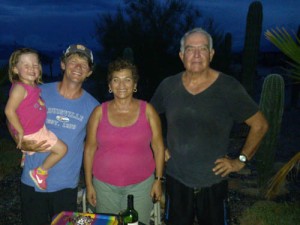
Hot as it was, Bahia de Los Angeles was a magical place. Brian was especially excited to be there. Thirteen years ago he, along with two other teachers, led a group of middle school students from Colorado on an adventure through Baja. They spent a week in Bahia learning about the culture, ecology and biology of the area, and helping out at a sea turtle rescue center. To our good fortune, the marine biologist who ran the turtle center, Antonio Resendiz, was still in Bahia and we spent a wonderful evening with him and his wife at their amazing home that they built themselves overlooking the sea.

Antonio also hooked us up with a local guide who took us on a boat tour of the bay with the hopes of spotting some whale sharks, which are not whales or sharks, but are the world’s largest fish! Not only did we spot whale sharks, we got to SWIM with them! Half a dozen, to be exact! Brian and I took turns snorkeling alongside these magnificent creatures while Maya watched from the boat. The whale sharks dwarfed us – some were at least 20 ft long. When they opened their cavernous (toothless, thank god) mouths to feed, it felt like you might get sucked right down!
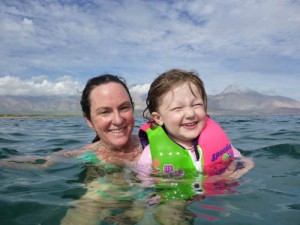
But Maya wasn’t content with watching for long. After our first go with the whale sharks, she insisted on getting in the water with us. Once she was in, she didn’t want to get out! Every time we stopped the boat to jump in the water and swim with the whale sharks, she asked to go with us! I think I can safely say that Maya might be one of only a few three year olds in the United States that has swam with whale sharks. This was her first excursion out on the open ocean. She was so brave, curious and excited. She also loved the boat ride and seemed completely comfortable speeding along the water. My heart filled with pride that day thinking that my little girl could end up being an ocean lover like her mama! 🙂
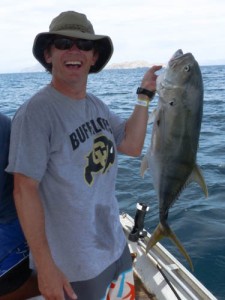
During our excursion, Brian also caught two enormous “toro” fish – weighing about 20 lbs each! Again, Maya was super excited about the whole event – but not quite as excited as Brian to land the biggest catch of his fishing career so far. We both agreed that our day on the sea was one of the best ocean experiences we had ever had in our lives.

Bahia de Los Angeles is a muy tranquilllo – very tranquil – place. It is the only town at the end of a 68 kilometer (paved) offshoot from the main highway bisecting the peninsula from top to bottom. There is only one main paved road through town, maybe only a mile long, dotted with a few small hotels, mini markets, snack shops and restaurants. All the other roads around the bay are dirt. Many are washed out in low-lying areas – evidence of last year’s Hurricane Odile. Along these dirt roads that line the coast are a smattering of RV and tent campsites, palapas, small hotels, simple homes, fisherman shacks and hybrid RV-cabin structures similar to the one we stayed in at Puerto Santo Tomas. The bay itself is expansive with more than a dozen islands.

Most tourists come here for deep-sea fishing or to go whale watching in the winter. The beaches are calm and clear – especially in the morning when there is no wind. Some are sandy but most are rocky. We learned quickly that you want to stick to the rocky beaches. Small but feisty Cortez stingrays hide in the sand under the water, especially at low tide. Brian got nabbed on his foot his second day in the water, which was super painful. The remedy was perhaps even more painful than the sting – which was to stick his foot in scalding hot water for 30 minutes. Sadly to say, it was about an hour of sheer agony for Brian between the actual sting and the soak, but luckily the pain went away after that. After that experience, we now always make sure to shuffle our feet when entering a sandy beach.
We were in Bahia off-season, so most of the town and hotels were deserted – not that it ever gets really busy or crowded. There were a few fishermen staying at Daggats while we were there, including a gregarious Yugoslavian man in his 70s, and his equally gregarious adopted Serbian son, who generously gave us filets of yellowtail that we fried up with butter and onions and made some awesome fish tacos. That was a decadent meal. We’ve been eating pretty simply and cheaply overall. If not for the fish, we would have been eating ramen and hot dogs that night. But, honestly, I’d rather spend our money paying a premium for air conditioned motel rooms than eating at nice restaurants. 🙂
Next stops: San Ignacio and Loreto!

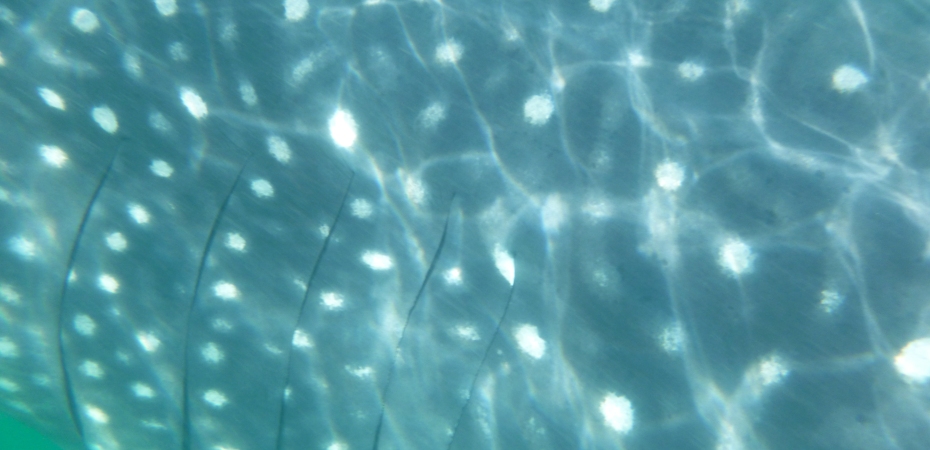
A great adventure, Deb. It’s wonderful that you are writing and documenting your trip.
Love,
Mom
LikeLike
Love reading about your adventures and remembering our own experiences in some of the same places! It’s amazing that Maya is so adventurous in the water. Way to go! We didn’t see any whale sharks in Baja, but we did get to swim with them in Mozambique all those years ago. They are truly amazing creatures.
LikeLike